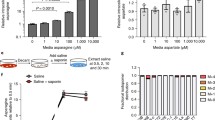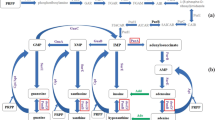Summary
Cultured human pancreatic carcinoma cells (MIA PaCa-2) have been shown previously to be very sensitive toE. coli l-asparaginase (EC II). The present studies have demonstrated that another enzyme,Acinetobacter glutaminase-asparaginase (AGA) is much more effective in inhibiting cell growth. At the concentration of 0.0025 U/ml of AGA activity the enzyme totally inhibited cell growth, whereas the EC II with the same concentration did not show any effect. The inhibition of cell growth correlated well with inhibition of protein and glycoprotein synthesis. The addition ofl-glutamine at the concentration of 1 mM completely reversed the inhibition of protein synthesis. Similarly, the addition ofl-glutamine at the concentration of 3 mM daily on 3 successive days after adding AGA resulted in significant reversal of growth inhibition. The results of this study indicate that the action of AGA on MIA PaCa-2 is, to a great extent, exerted through itsl-glutaminase activity.
Similar content being viewed by others
References
Yunis, A. A.; Arimura, G. K.; Russin, D. J. Human pancreatic carcinoma (MIA PaCa-2) in continuous culture: Sensitivity to asparaginase. Int. J. Cancer 19: 128–135; 1977.
Schultz, D. R.; Yunis, A. A. Tumor associated antigen(s) in human pancreatic cancer. J. Natl. Cancer Inst. 62: 777–785; 1979.
Wu, M.-C.; Arimura, G. K.; Yunis, A. A. Purification and characterization of a plasminogen activator secreted by cultured human pancreatic carcinoma cells. Biochemistry 16: 1908–1913; 1977.
Wu, M.-C.; Arimura, G. K.; Yunis, A. A. Mechanism of sensitivity of cultured pancreatic carcinoma to asparaginase. Int. J. Cancer 22: 728–733; 1978.
Cooney, D. A.; Handschumacher, R. E.l-Asparaginase andl-asparagine metabolism. Ann. Rev. Pharmacol. 10: 421–440; 1970.
Oettgen, H. F.; Old, L. J.; Boyse, E. A.; Campbell, H. A.; Phillips, F. S.; Clarkson, B. D.; Tallal, L.; Leeper, R. D.; Schwartz, M. K.; Kim, J. H. Inhibition of leukemias in man byl-asparaginase. Cancer Res. 27: 2619–2631; 1967.
Ohnuma, T.; Holland, J. F.; Freeman, A.; Kinks, L. F. Biochemical and pharmacological studies with asparaginase in man. Cancer Res. 30: 2297–2305; 1970.
Wriston, J. C., Jr.; Yellin, T. O.l-Asparaginase: A review. Advanc. Enzymol. 39: 185–248; 1973.
Becker, F. F.; Broome, J. D.l-Asparaginase: Inhibition of early mitosis in regenerating rat liver. Science 156: 1602–1603; 1967.
Bosmann, H. B.; Kessel, D. Inhibition of glycoprotein synthesis in L5178Y mouse leukemic cells byl-asparaginein vitro. Nature 226: 850–851; 1970.
Mashburn, L. T.; Landin, L. M. Inhibition of thymidine and basic amino acid metabolism in P1798 lymphosarcoma byl-asparaginase. Cancer Res. 34: 313–318; 1974.
Seeber, S.; Weser, U. Inhibition of [3H]thymidine incorporation into rat liver nuclei byE. coli asparaginase. Nature 225: 652–653; 1970.
Roberts, J.; Holcenberg, J. S.; Dolowy, W. C. Isolation, crystallization, and properties ofAchromobacteraceae glutaminase-asparaginase with antitumor activity. J. Biol. Chem. 247: 84–90; 1972.
Roberts, J.; Holcenberg, J. S.; Dolowy, W. C. Antineiplastic activity of highly purified bacterial glutaminase. Nature 277: 1136–1137; 1970.
Roberts, J.; Holcenberg, J. S.; Dolowy, W. C. Glutaminase induced prolonged regression of established Ehrlich carcinoma. Life Sci. 10: 251–255; 1971.
Holcenberg, J. S.; Robert, J.; Dolowy, W. C. Glutaminase as antineoplastic agents. Prusiner, S.; Stadtman, E. eds. Enzymes as drugs. New York: Academic Press; 1973: 277–292.
Allen, L.; Meck, R.; Yunis, A. A. The inhibition of γ-glutamyltranspeptidase from human pancreatic carcinoma cells by (αS,5S)-α-amino-3-chloro-4,5-dihydro-5-isoxazoleacetic acid (AT-125; NSC-163501). Res. Commun. Chem. Pathol. Pharmacol. 27: 175–181; 1980.
Author information
Authors and Affiliations
Additional information
This work was supported in part by USPHS Grant CA 19182. Dr. Wu is recipient of Research Career Development Award Grant CA00686 and Dr. Yunis is a Howard Hughes Investigator.
Rights and permissions
About this article
Cite this article
Wu, MC., Arimura, G.K., Holcenberg, J.S. et al. Sensitivity of cultured pancreatic carcinoma cells toAcinetobacter glutaminase-asparaginase. In Vitro 18, 750–754 (1982). https://doi.org/10.1007/BF02796498
Received:
Accepted:
Issue Date:
DOI: https://doi.org/10.1007/BF02796498




